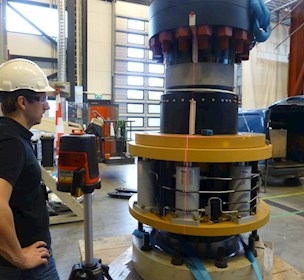Proactive structural monitoring for enhanced asset safety and efficiency
Enhance asset safety and extend service life with FORCE Technology’s proactive structural monitoring for offshore structures.
Offshore and subsea structures are constantly exposed to extreme environmental forces, which can impact their long-term integrity. To help operators address the issue, FORCE Technology has developed high-quality structural monitoring solutions that can help extend asset lifespans, as well as improve safety and optimise maintenance strategies.
Acquiring vital data across diverse assets
According to Pål Tuset, Principal Engineer, Structural Monitoring at FORCE Technology, “Our expertise spans a wide range of applications, from flexible risers and rigid pipelines to wind turbine foundations and anchoring systems. We ensure that clients receive accurate, real-world data that enables them to make well-informed decisions.”
FORCE Technology’s solutions address a broad spectrum of monitoring needs. Our work with pipelines and risers involves measuring strain, bending moments, and torsion, which provides operators with crucial information to maintain and enhance their infrastructure. Jacket structures and anchoring systems require continuous assessment of tension, movement, and vibrations to prevent unexpected failures. In the offshore wind sector, monitoring structural loads and responses helps operators improve investment security and extend the service life of turbine foundations. The same expertise also applies to topside process equipment, where tracking vibrations and operational stability ensures efficiency and safety.
With applications ranging from deep-sea installations to towering wind turbines, FORCE Technology develops monitoring solutions tailored to each project’s specific requirements. “Whether dealing with assets operating at thousands of meters below sea level or structures subjected to high wind loads, we have the expertise and technology to deliver accurate and actionable insights,” Pål explains.
Harnessing advanced sensor technology for precision monitoring
Structural monitoring relies on precise data collection, and FORCE Technology integrates state-of-the-art sensor systems to deliver real-time insights into asset conditions. This can include electrical strain gauges and fibre optic sensors, which are installed on new structures for accurate strain measurements, as well as displacement sensors (LVDTs), which are often used to retrofit older assets and can be deployed by remotely operated vehicles (ROVs) in deep-sea environments, or by divers and technicians. Inclination and acceleration sensors provide further data on how environmental forces impact offshore structures.
“Our monitoring solutions are designed to provide operators with a continuous stream of accurate data, ensuring they can track the performance of their assets in real time,” says Pål. The collected data helps operators predict maintenance needs, optimise inspection schedules, and make decisions that reduce unnecessary downtime. Whether used for real-time monitoring via cable or hydroacoustics, or stored autonomously for later retrieval, the insights provided by FORCE Technology's systems are invaluable in ensuring asset reliability and performance.
Data-driven decision-making for operational optimisation
A core value of structural monitoring is in how the data is used. FORCE Technology provides solutions that help operators transition from routine inspections to a more data-driven approach, ensuring maintenance and operational decisions are based on real-world conditions. “For some clients, immediate data access is crucial for operational decisions, such as knowing when to disconnect a drilling rig due to shifting environmental conditions,” explains Pål. “For others, long-term monitoring helps extend asset life by optimising inspection schedules and reducing maintenance costs.”
Structural monitoring is integral at all stages of an asset’s lifecycle. During the design phase, it is part of the integrity management strategy to meet the required service life. During operation, it is used to confirm design assumptions and service life models based on real-world data and exposure, and it enables load control and performance optimisation.
As an asset approaches the end of its design life, monitoring helps assess its remaining service potential, ensuring safe and cost-effective decision-making. In the offshore wind industry, for example, operators design turbines for 25-year lifespans but often seek to extend their use. Structural monitoring provides the necessary data to justify turbine life extensions, reducing the need to build and install new turbines and leveraging more value from existing assets.
Tailored monitoring solutions for every challenge
Every monitoring project presents unique challenges, and FORCE Technology delivers customised solutions that encompass system design, fabrication, sensor installation, and long-term data acquisition. “Our strength lies in developing solutions specific to each project,” says Pål. “We design and test our monitoring systems, install them on-site, and provide ongoing support to ensure they continue to deliver accurate results.”
Although FORCE Technology primarily focuses on delivering monitoring hardware and technology, its team also supports clients in understanding and interpreting the collected data. “We don’t just provide the tools – we help clients validate their monitoring results, ensuring they make informed decisions based on accurate insights,” explains Pål.
This collaborative approach enables FORCE Technology to enhance structural integrity for clients based on expertise and historical insight, ensuring that operators have the information they need to maintain reliability, improve efficiency, and maximise the lifespan of critical infrastructure.



